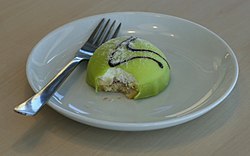Princess cake
 Homemade Swedish princess cake | |
| Alternative names | Prinsesstårta, grön tårta, prinstårta, prinsessbakelse |
|---|---|
| Type | Cake |
| Place of origin | Sweden |
| Created by | Jenny Åkerström |
| Main ingredients | Sponge cake, whipped cream, raspberries, pastry cream, marzipan, powdered sugar |
Princess cake or princess torte[1][2] (Swedish: prinsesstårta) is a traditional Swedish layer cake or torte consisting of alternating layers of airy sponge cake, pastry cream, and a thick-domed layer of whipped cream. The cake is covered by a layer of rolled marzipan, giving it a smooth, rounded top. The marzipan overlay is usually green, sprinkled with powdered sugar, and often decorated with a pink marzipan rose.[3][4] While the original recipe did not contain any fruit, modern versions usually include layers of jam[4] or fresh fruit, usually raspberries.
Origin and name
[edit]The original recipe first appeared in the 1948 Prinsessornas kokbok cookbook, which was published by Jenny Åkerström (1867–1957), teacher of the three daughters of Prince Carl, Duke of Västergötland.[5]
The cake was originally called grön tårta (green cake), but was given the name prinsesstårta or "princess cake" because the Swedish princesses were said to have been especially fond of the cake. The princesses were Princess Margaretha (1899–1977; later Princess of Denmark), Princess Märtha (1901–1954; later Crown Princess of Norway), and Princess Astrid (1905–1935; later Queen of the Belgians).[6][7][8]
Name and variants
[edit]Prinsesstårta has historically been called, or appeared in variants known as, green cake, regent cake, and opera cake.[9]
Variants with different colors of marzipan covering may be called prince cake, and sometimes Carl Gustaf cake when covered with yellow marzipan. A frog is a type of pastry that (aside from a bit of buttercream) is a smaller kind of prinsesstårta decorated to resemble a frog’s face, where a cut in the marzipan forms the mouth.
Variants with jam in the bottom layer are often called opera cake.[10]
One theory behind the cake being called prinsesstårta is that the princesses taught by home economics teacher Jenny Åkerström were especially fond of it.[11] Another theory links the name to princess almond (prinsessmandel), which during the latter half of the 19th century and first half of the 20th century was marketed as the finest variety of almond.[12]
Variants with other colours of marzipan are occasionally called prinstårta (prince cake) for yellow marzipan and operatårta (opera cake) for red or pink marzipan.
It's traditional to fight over who get the marzipan rose. Since 2004, there's been a "princess cake week" in Sweden held each September, with proceeds going to a royal charity.[13]
-
Individual serving size
-
Pink and gold
-
Green with marzipan rose
-
Decorated with a Christmas theme
Theme week
[edit]
Since 2004, the organization Sveriges bagare & konditorer (Sweden's Bakers & Confectioners) has promoted the last week of September as "Princess Cake Week".[14]
The first Thursday in March has become a well-known concept, primarily in Småland, where princess cake is eaten on this day. This is because the first Thursday in March is Småland's unofficial national day, and to honor the Småland dialect, it is called "fössta tossdan i mass".[15]
Storage
[edit]Princess cake contains cream and can be stored in the refrigerator for several days, or frozen. The powdered sugar melts when it becomes moist. To prevent this, moisture-resistant powdered sugar can be used, or it can be dusted on just before delivery or serving.[16]
See also
[edit]- Frog cake, a broadly similar Australian dessert[4]
- List of almond dishes
- List of cakes
References
[edit]- ^ Melody Favish (17 June 2008). Swedish Cakes and Cookies. Skyhorse Publishing Inc. pp. the Page: 156, or see the index in the section (Cakes and Tortes). ISBN 978-1-60239-262-5.
- ^ Greg Patent (2007). A Baker's Odyssey: Celebrating Time-honored Recipes from America's Rich Immigrant Heritage. John Wiley & Sons. p. 289. ISBN 978-0-7645-7281-4.
- ^ "Prinsesstårta: Swedish Princess Cake". thespruceeats.com. Retrieved March 1, 2020.
- ^ a b c Holgate, Emily (4 July 2025). "The Swedish princess cake is the latest retro dessert on the rise". Good Food (The Age). Retrieved 25 July 2025.
- ^ "Princess cake demystified (prinsesstårta)". 2011-09-21. Retrieved 2015-05-31.
- ^ "Traditionsenlig tårtfrossa - Prinsessyra bäddar för prinsesstårtans vecka" (in Swedish). Cisionwire. 2009-09-17. Archived from the original on 2010-10-17. Retrieved 2009-12-19.
- ^ "Royal Dilemma: Why is the Princess Cake Green?". 2008-11-12. Retrieved 2012-08-20.
- ^ Vera (2009-02-24). "Swedish Princess Cake". Retrieved 2014-01-26.
- ^ Aftonbladet (1950-06-29) p.18
- ^ "Prinsesstårta". alltommat.se. 2 December 2008. Archived from the original on 2 December 2008.
- ^ Cision Wire Archived 2010-10-17 at the Wayback Machine
- ^ tidningar.kb.se, Prinsessmandel, accessed 2021-07-21
- ^ Beckett, Lois (12 July 2025). "It's sexy! It's Swedish! It's everywhere! How princess cake conquered America". The Guardian. Retrieved 12 July 2025.
- ^ Sveriges bagare & konditorer 2009-11-20 Archived 2010-08-12 at the Wayback Machine
- ^ "Fössta tossdan i mass – så firas Smålands nationaldag". Aftonbladet. 7 March 2019. Retrieved 15 November 2019.
- ^ "Fuktbeständigt Florsocker Decora 250g - BakeCake" (in Swedish). Retrieved 2024-10-23.




